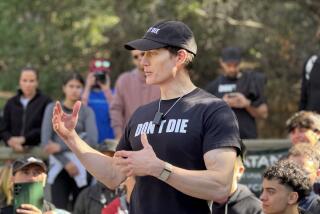Doctor Urges Exercise to Avert Geezer Boom
WASHINGTON — Boomer today, geezer tomorrow.
And tomorrow may be here sooner than you think, doctors are warning 40- to 50-year-olds who seem set in their non-exercising ways.
“We are trying hopefully to get a little fear in them,” said Dr. Gerald F. Fletcher of the Mayo Clinic, Jacksonville, Fla.
Fear of disease and death could turn out to be a good motivator, said Fletcher, lead author of an American Heart Assn. statement published in the American Heart Assn. journal, Circulation. Lack of exercise is among the association’s top five coronary heart disease risk factors that a person can change.
And a visit to the doctor, when patients are already thinking about their health, is a good opportunity to hammer the message home, Fletcher said.
The advisory report is a call for doctors to free some time during an ordinary office visit to counsel patients on exercise. “I really think doctors can spend 30 seconds,” Fletcher said.
Boomers, typecast as the eternal teenagers, also are beginning to feel the loss of their youth, said exercise physiologist Russell R. Pate of the University of South Carolina.
“Baby boomers are people who are in many cases used to being able to do things physically when they want to,” Pate said. Seeing those abilities start to go “is in fact motivating.”
Internists are trying to carve a market share among the middle-aged, with ads that describe themselves as “Doctors for Adults.” “Because whatever else you are, you’re not a kid anymore,” the ads say.
Part of this effort is encouraging exercise, said internist Sandra Adamson Fryhofer of Atlanta, national spokeswoman for the American College of Physicians’ campaign.
Fryhofer advises many of her patients to think back to the sports they liked when they were younger, and try them again. For instance, a lot of people used to swim or dance, both of which are excellent aerobic activities, she said. And even those who played baseball or softball, which is not an aerobic activity, might be persuaded to go back into training so they can play again, she said.
The reluctant exerciser might also be led into the fun of fitness by starting something as simple as brisk walks, Fletcher said. “If they don’t know what to do, I say, ‘Get out and walk,’ ” he said. But exercise must be tailored to the individual; no one form works for everyone, he said.
Nor does one approach to motivation, Pate said.
The truly sedentary, who have no idea about exercise, must first be shown that they can do it and that it will do them good, Pate said. Walking works well for these people in part because it’s not intimidating--they know how to walk, and they don’t have to compare their bodies against serious exercisers when they do it.
Another group exercises sporadically but can’t turn exercise into a habit, Pate said. These people need to learn to prioritize--to make exercise a more important part of their lives, he said. A committed exerciser makes it a point to work in a workout, even in a busy day, while the non-committed just hopes to find the time, he said.
For instance, a regular exerciser might push back dinner in order to work out, while the sporadic exerciser will have dinner and push back exercise to another day, Pate said. “Before you know it, it hasn’t been fitted in, and it’s not going to be fitted in,” he said.


